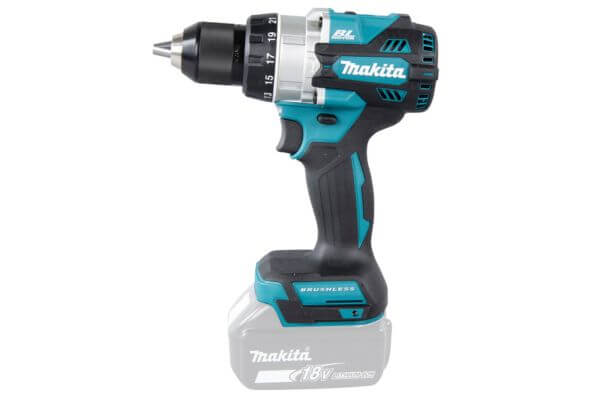
Voltage : 18 V
Motor type : Brushless
Max torque (hard/soft) : 54 / 30 Nm
Advertised max torque : 65 Nm
Max no-load speed : 0-500 / 2000 rpm
Max impacts per minute (IPM) : 30 000 ipm
Drilling capacity masonry : 13 mm
Drilling capacity steel : 13 mm
Drilling capacity wood (drill bit) : 38 mm
Drilling capacity wood (Forstner bit) : -
Hole saw capacity : 51 mm
Torque settings : 21 positions
Dimensions (L × W × H) : 182 x 79 x 261 mm
Net weight (without battery) : 1,2 kg
Noise level (Lpa) : 88 dB(A)
Vibration drilling metal : ≤ 2,5 m/s²
Vibration drilling concrete : 8,0 m/s²
Dust/water protection (XPT) : Not specified

Voltage : 18 V
Motor type : Brushless
Max torque (hard/soft) : 130 / 65 Nm
Advertised max torque : 141 Nm
Max no-load speed : 0-550 / 2100 rpm
Max impacts per minute (IPM) : 31 500 ipm
Drilling capacity masonry : 13 mm
Drilling capacity steel : 13 mm
Drilling capacity wood (drill bit) : 50 mm
Drilling capacity wood (Forstner bit) : 76 mm
Hole saw capacity : 152 mm
Torque settings : 21 positions
Dimensions (L × W × H) : 178 x 81 x 265 mm
Net weight (without battery) : 1,7 kg
Noise level (Lpa) : 84 dB(A)
Vibration drilling metal : ≤ 2,5 m/s²
Vibration drilling concrete : 8,0 m/s²
Dust/water protection (XPT) : Yes
| Criteria | DHP484 | DHP486 | Verdict |
|---|---|---|---|
| Voltage | 18 V | 18 V | Tie |
| Motor type | Brushless | Brushless | Tie |
| Max torque (hard/soft) | 54 / 30 Nm | 130 / 65 Nm | DHP486+140% torque |
| Advertised max torque | 65 Nm | 141 Nm | DHP486+117% torque |
| Max no-load speed | 0-500 / 2000 rpm | 0-550 / 2100 rpm | DHP486~5% faster |
| Max impacts per minute (IPM) | 30 000 ipm | 31 500 ipm | DHP486+5% IPM |
| Drilling capacity masonry | 13 mm | 13 mm | DHP486+23% capacity |
| Drilling capacity steel | 13 mm | 13 mm | Tie |
| Drilling capacity wood (drill bit) | 38 mm | 50 mm | DHP486+32% capacity |
| Drilling capacity wood (Forstner bit) | - | 76 mm | DHP486Not available on DHP484 |
| Hole saw capacity | 51 mm | 152 mm | DHP486+198% capacity |
| Torque settings | 21 positions | 21 positions | Tie |
| Dimensions (L × W × H) | 182 x 79 x 261 mm | 178 x 81 x 265 mm | TieNegligible difference |
| Net weight (without battery) | 1,2 kg | 1,7 kg | DHP48429% lighter |
| Noise level (Lpa) | 88 dB(A) | 84 dB(A) | DHP4864 dB quieter |
| Vibration drilling metal | ≤ 2,5 m/s² | ≤ 2,5 m/s² | Tie |
| Vibration drilling concrete | 8,0 m/s² | 8,0 m/s² | Tie |
| Dust/water protection (XPT) | Not specified | Yes | DHP486 |
Makita DHP484
Power
Compactness & Handling
Versatility
Value for Money
Makita DHP486
Power
Compactness & Handling
Versatility
Value for Money
Discover our in-depth reviews of other models to help you refine your choice:
Makita DHP481 vs DHP486
Head-to-head: DHP481 vs DHP486 – The guide to choosing right
Makita DHP482 vs DHP484
DHP482 or DHP484: which one really stands out for your DIY projects?
Makita DDF484 vs DHP484
DDF484 vs DHP484: key specs breakdown to choose confidently.
Makita DHP481 vs DHP484
Makita DHP481 or DHP484: Speed and balance vs raw strength.